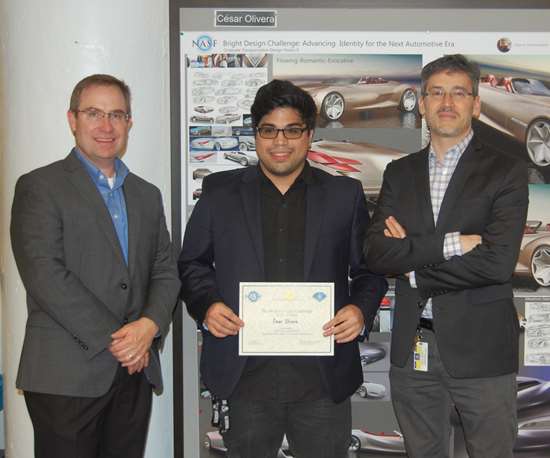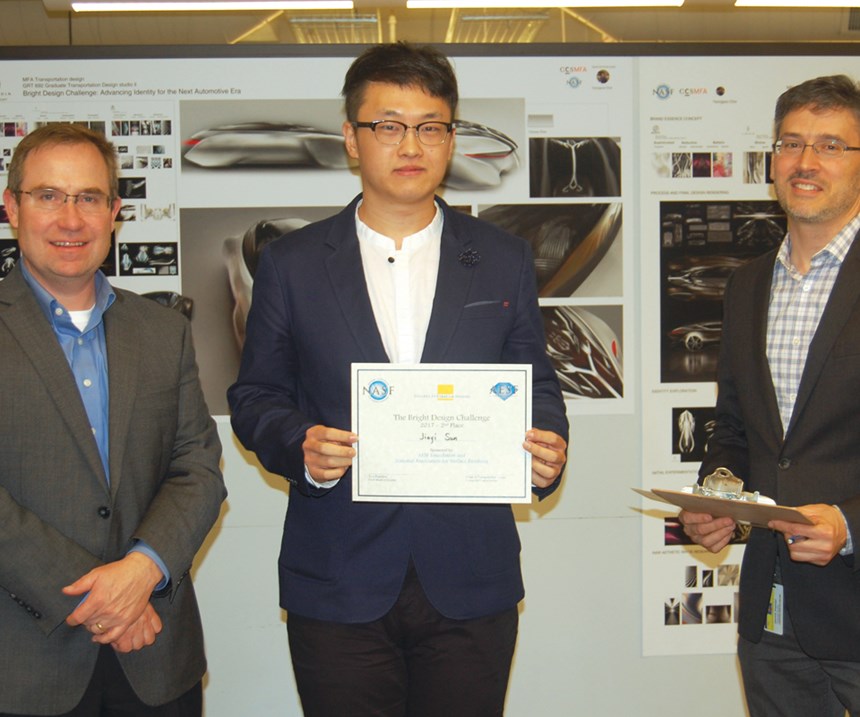NASF Report: August 2017
The NASF Bright Design Challenge took on a new look and feel this spring with the theme “Advancing Brand Identity for the Next Automotive Era.” The competition included 12 graduate students who devoted their semester to envisioning the role of metal finishing in automotive designs for 2025 and 2050 vehicle models.
#automotive #nasf #surfin
The NASF Bright Design Challenge took on a new look and feel this spring with the theme “Advancing Brand Identity for the Next Automotive Era.” Twelve graduate students devoted their semester to envisioning the role of metal finishing in automotive designs for 2025 and 2050 vehicle models.
With NASF’s partnership with the College for Creative Studies (CCS) in Detroit, Michigan, the two winning designs were showcased in a video at the NASF pavilion during this year’s Sur/Fin show in Atlanta, Georgia.
Featured Content
To view and download the video demos, visit nasf.org.
Guiding the Automotive Design of Tomorrow
As the future of mobility makes potentially radical demands, NASF views the Bright Design Challenge as an opportunity to educate and inspire today's students that will be working in the industry and designing cars for years to come.
“Working with CCS faculty and students at the undergrad and graduate level is an incredible way to help them understand the role of finishing in automotive applications, and it will be more important than ever to keep them updated on what our industry has to offer in the future,” said Brian Harrick, vice president at KC Jones Plating.
A group of industry leaders worked to inspire the students to think in terms of finishing as a way to add value and style to their designs. Representatives from Haviland, MacDermid Enthone, Coventya, Atotech, Marsh Plating, KC Jones Plating and NASF headquarters all helped the students understand how surface finishing is essential to their designs.
Larger Trends Driving Demands on the Future of Finishing
Instructor for this year’s course and former designer at Ford Motor Co., Raphael Zammit has been passionate about the chance for the students to gain more knowledge about how finishing fits into an automotive future that will demand different approaches to design and branding.
He emphasized to the students that over the past century, vehicle identities or “faces” have evolved almost primarily from the design of major functional components such as air intakes or grilles and head lamps. Next generation vehicles, however, will rely less, if at all, on such components due to continual advances in technology.
“The exploration, development and innovative articulation of surface finishes offer an exciting and wholly appropriate avenue for expressing identity in an entirely new context in the coming era of advanced mobility,” Zammit told the students.
2017 Bright Design Challenge – Course Objectives:
- Design a 2025 and 2050 concept vehicle for a Lincoln, Buick or Acura, and choose a 2025 or 2050 concept for a final design;
- Create new conventions of identity on both the brand and vehicular level through the unconventional research and application of material, color, texture, pattern and form as expressed through surface finishing;
- Employ the concept of researched “aesthetic messaging” to elevate the use of surface finishing beyond styling decor into “communicative language devices;” and
- Celebrate the full creative and expressive potential of surface finishing through the creation of visually compelling video animations that highlight the surface concepts (by targeting viewers’ focus to those areas on the vehicle).
Top Two Winners:
- Cesar Olivera: 2025 Buick Evocador,
- Jiayi Sun: 2050 Acura Sheer Precision
NASF Bright Design Task Group:
- Brian Harrick, KC Jones Plating;
- Bernie Haviland, Haviland USA;
- Mitch Marsh, Finishing Services;
- Christian Richter, NASF.
NASF Sponsors, Experts and Judges:
- Doug Lay, Coventya;
- Rob Pawson, Haviland USA;
- Joe Randazzo, Atotech;
- Mark Wojtaszek, MacDermid Enthone.
Originally published in the August 2017 issue.
RELATED CONTENT
-
Sizing Heating and Cooling Coils
Why is it important for you to know this?
-
Gold and Silver Plating Basics
An overview of precious metal electroplating processes.
-
Choosing and Troubleshooting Copper Electroplating Processes
Learn more on this inexpensive and highly efficient process.





















